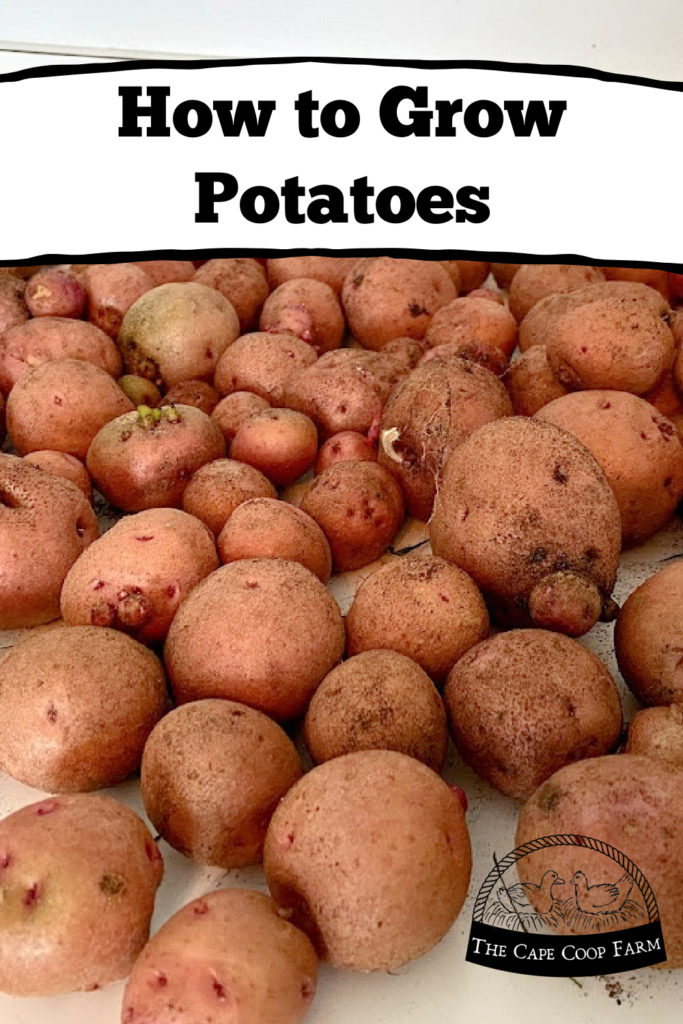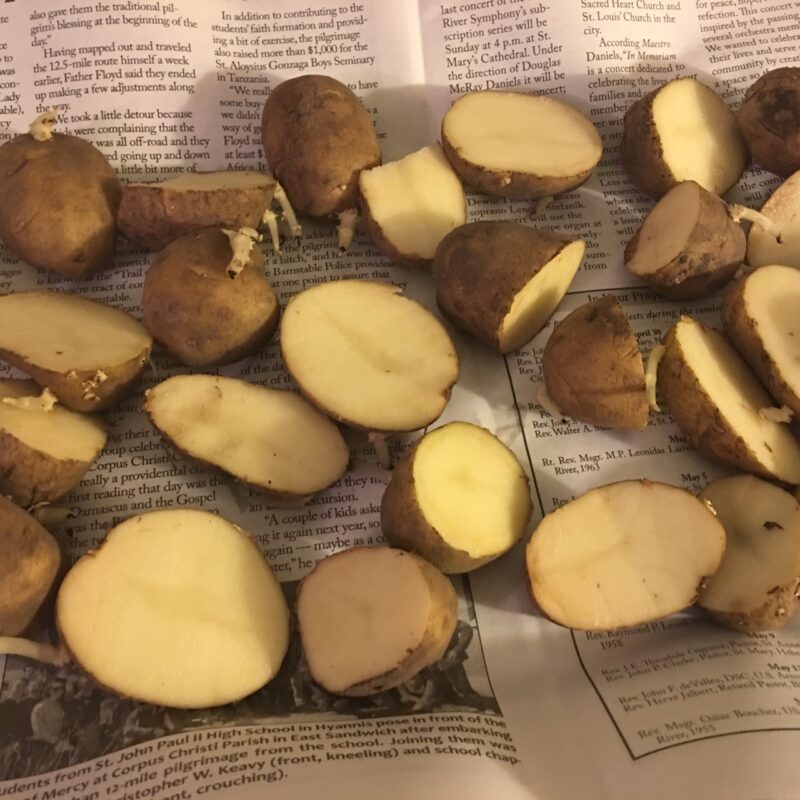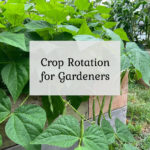---------------------------------------------------------
For many years, I avoided growing potatoes. I thought they needed a lot of space and they weren’t practical for backyard gardens. I was so wrong! Potatoes are not only a great addition to the backyard garden, but they are really easy to grow. They are a cold-weather crop that grows well in the northern half of the country. Potatoes are hardy enough that they can even survive a light frost. Aim to plant the seed potatoes in early spring, a few weeks before your area’s last frost date.
Anatomy of a potato plant
A potato is a tuber. A tuber is a thickened underground food storage unit to feed the plant. The part of the plant that is above ground consists of leaves, flowers, and sometimes small fruits. The fruit of a potato plant are small, round & green and look similar to a cherry tomato. They are NOT edible. The potato fruit has high levels of solanine, which can make humans very ill. Below the ground are the roots and the tubers (potatoes). The tubers are attached to the main underground stem by stolons.
Preparing the ground
Potatoes like rich, organic, loose soil. If the soil is hard or compacted the tubers will not grow at all or they will grow misshaped. If you have the space and good soil, potatoes can be planted in rows right in the ground. I grow my potatoes in a raised bed so I can control the quality of the soil. Potatoes can also happily grow in large containers, bags, towers and more!
Be sure to practice crop rotation when growing potatoes. To prevent plant diseases from accumulating in the soil, do not plant your potatoes where members of the nightshade family have grown in the previous year (tomatoes, potatoes, peppers, eggplant)
Preparing the seed
When growing potatoes, you want to start with quality seed potatoes. Can you grow potato plants from potatoes you bought at the grocery store that have sprouted? Yes, you *can* do it, but you will see much better harvests from seed potatoes. Grocery store potatoes are treated with chemicals to help preserve them and keep them from sprouting in your pantry. This is obviously not good if you want them to sprout! If you have to use store-bought potatoes, choose organic so they will be untreated.
Certified seed potatoes will also be guaranteed to be disease-free. There are several diseases potatoes are susceptible to. They can affect the current year’s crop, but could also contaminate your soil for future years. It’s best not to risk it and just start with seed potatoes.
If you order your seed potatoes and they come before you are ready to plant them, store them in a cool, dark location. This will keep them from sprouting prematurely. If you store them in the refrigerator, or a cold basement or garage, let the potatoes sit out at room temperature for about a week before planting.
You should cut each seed potato into several pieces. You want to ensure you have at least two eyes per piece. After cutting the potatoes up, lay them on some newspaper and let them sit for a day. This will allow the newly cut pieces to form a protective “scab”. It will help them retain moisture and prevent rotting once in the ground.
Planting
Dig a hole about 4 inches deep. Place the seed potato in the hole, with the eyes facing up. Space plants about a foot apart. Cover with soil and keep the area moist. It will take 2-3 weeks before you’ll see the plants emerging from the ground.
Care
When the plants are about 6 inches tall, mound up the soil around the stem. This will support the plant, but more importantly, it will ensure all the tubers are covered. If tubers form near the soil and get exposed to light while forming they will turn green. Green potatoes are very bitter because a poisonous sustenance called solanine is building up in the potato’s flesh.
Every few weeks remound the soil around the plant if needed. Many gardeners will add a thick layer of straw around the plants. The straw helps retain moisture and helps keep the tubers in the dark. It also keeps the soil temperature down. Potato tubers will grow the best in soil temperature between 60-70 degrees. The hotter the soil gets, the less the tubers will grow.
Harvesting
When the plant begins to flower, this is when peak tuber growth is happening below the ground. If you want small, new potatoes, you can harvest 2-3 weeks after the plant begins to bloom. For the biggest potato harvest, you should remove the flowers as you see them. When a plant flowers it uses a lot of energy to produce the flower and seeds. If you remove the flower that energy can be diverted to the tubers.
For full-size potatoes wait until the plant dies (I usually plant in mid April and harvest late August/early September). Be careful when digging for potatoes, you don’t want to puncture them! Brush the dirt off, but don’t wash them until you are ready to use them. Store potatoes in a cool, dry, dark location.










Pamela Prince
Thursday 10th of May 2018
I discovered your blog today and have not been able to pull myself away from my laptop! Your no-nonsense advice is very helpful and you have obviously learned by doing so I am delighted to have found you! I have not found better potato-growing instructions anywhere! I am lacing up my sneakers to go to my local greenhouse to grab some seed potatoes right now. Thank you so much!
Liz
Thursday 10th of May 2018
Thank you Pamela! I'm glad I could help :)
Alicia Owen
Monday 6th of June 2016
Potatoes are about the only thing we haven't tried growing. I always thought they were hard to grow, but I have read otherwise recently. Thanks for the info!